by Lee A. Silva
I’ve been avoiding getting into the Earp books because there is so much of Wyatt Earp everywhere you look when it comes to the old west, and particularly historical research, but my want to get this book mentioned and put up on the blog caused me to finally start into the Earp section of the ol’ personal western library.
Lee Silva’s biography is far and away the best resource for studying Wyatt Earp. I’m going to go ahead and just start with that as my jumping off point. It’s true. Unfortunately most people haven’t read it because it’s out of print and most used copies start at around 250.00 on amazon. Though I did see one the other day going for 95, and I considered getting a second just as back-up at that price. But, to stay on course, let me back up my claims.
Finding a good, I mean really good, biography of Wyatt can be challenging since his life is so enigmatic to so many people. This is generally why there are so many biographies of the man; everyone has an angle to indulge. Thus we get half a dozen books just on whether or not he spent the winter of 1878 in Texas with his brother, saying nothing of the dozens of books covering his time in Tombstone and whether he was a good guy or not. But this is indicative of why Lee Silva’s biography could be safely rounded up to one-thousand pages, or in simpler terms, seven pounds. That’s a heavy book.
Mr. Silva took the time to do more than just collect the newspaper articles, or peruse the many statements of those living in Earp’s general breathing space; he does all that, and then he really weighs things out and breaks things down, comparing this note to that, and generally painting a picture that no other biographer of Wyatt Earp has done. And in the end, the result is that his first volume only covers up until Wyatt leaves Dodge City for Arizona.
So to clarify, volume one is around 900 pages and only covers up until the end of his time in Dodge City.
Take for example the debate over whether or not Wyatt stood down a mob of cow-boys in Wichita. Silva breaks down each move, and then provides a plethora of evidence and remembrances, and slowly structures all the information to make a real solid case for what actually happened. I’m, of course, not going to attempt to recount all this insightful information here, but these sorts of investigations are what make his book so amazing.
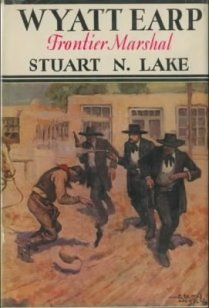 Another product of his excessively thorough research is that he presents a refreshed picture of Stuart Lake, proving that he was not the tall-tale-teller that so many have claimed he was. Silva extensively examines Lake’s notes and communications and often proves an indefatigable effort towards finding the truth. Perhaps Lake’s publishers had a hand in intentional mis-information, but when one fully considers all of Lake’s efforts it becomes clear that it is unfair to call the man a hack.
Another product of his excessively thorough research is that he presents a refreshed picture of Stuart Lake, proving that he was not the tall-tale-teller that so many have claimed he was. Silva extensively examines Lake’s notes and communications and often proves an indefatigable effort towards finding the truth. Perhaps Lake’s publishers had a hand in intentional mis-information, but when one fully considers all of Lake’s efforts it becomes clear that it is unfair to call the man a hack.
Towards the back of the book there is probably the best investigation of the Buntline Special in an appendix that trumps Shillingbergs’ book The Buntline Special Myth. But this is just another example of why this biography is so invaluable.
I’ll stop giving examples of why I think this book is so wonderful; I’m sure some people might be ready to accuse me of wanting to take the bible’s title of Good Book and appropriate it to this Earp biography, but fear not, I still believe the bible holds the number one spot. Buuuut….if we were talking strictly Earp history I might say it’s earned the title!
Ok, enough hyperbole.
I’ll wrap up with this: in the debate over who is the preeminent Wyatt Earp author and sage; is it Glenn Boyer with his history with the family, or Casey Tefertiller with his journalistic contributions and investigations, or one of the other qualified biographers? The answer is clear: Lee Silva is the main to attain to, and his biography is the one to read. Others are great, and ultimately shorter reads, but this is one heck of a “must” for the Study of Wyatt Earp.



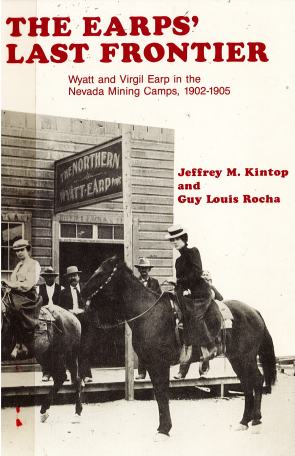 Earp’s Last Frontier is a great little book that covers time spent in Nevada by any of the Earp family, though focusing primarily on Wyatt, and secondarily on Virgil. Jeffrey Kintop and Guy Rocha do a great job of painting the Nevada picture without being overly blustery or trying to make a mountain out of a mole hill. For the casual fan who is rabidly eating up history books covering the gunfight in Tombstone may be underwhelmed, but for the in-depth enthusiast, this book really gives a good insight to the years after Alaska and before the California wind down.
Earp’s Last Frontier is a great little book that covers time spent in Nevada by any of the Earp family, though focusing primarily on Wyatt, and secondarily on Virgil. Jeffrey Kintop and Guy Rocha do a great job of painting the Nevada picture without being overly blustery or trying to make a mountain out of a mole hill. For the casual fan who is rabidly eating up history books covering the gunfight in Tombstone may be underwhelmed, but for the in-depth enthusiast, this book really gives a good insight to the years after Alaska and before the California wind down.
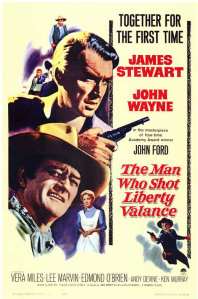 Starring Jimmy Stewart and John Wayne, this is one of John Ford’s later masterpieces. I love Ford because he brilliantly crafts stories, characters and cinematography in such a way that I come away not quite able to explain why I liked the movie so much. His craftsmanship is more subtle than Alfred Hitchcock’s and his movies not quite as epic as William Wyler’s. In an effort to understand why I like Ford movies so much I’ve actually started learning more about film. Not that I’m in danger of becoming a lofty film critic.
Starring Jimmy Stewart and John Wayne, this is one of John Ford’s later masterpieces. I love Ford because he brilliantly crafts stories, characters and cinematography in such a way that I come away not quite able to explain why I liked the movie so much. His craftsmanship is more subtle than Alfred Hitchcock’s and his movies not quite as epic as William Wyler’s. In an effort to understand why I like Ford movies so much I’ve actually started learning more about film. Not that I’m in danger of becoming a lofty film critic.
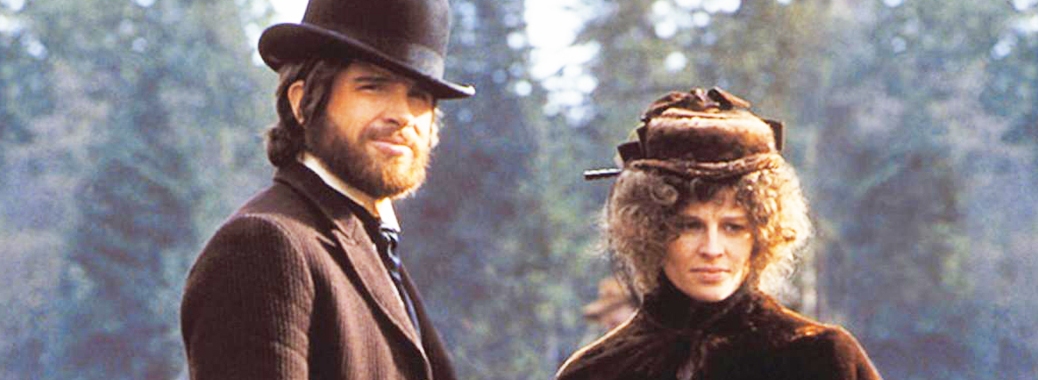
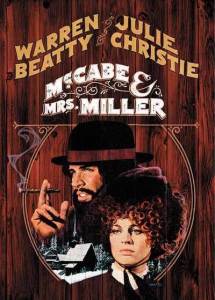 McCabe & Mrs. Miller is high on most lists of the greatest westerns of all time, especially as a prime example of the so-called revisionist western. As a fan of western movies, I would be remiss if I didn’t experience it. In honesty I didn’t expect to enjoy it as much as the sprawling, adventurous westerns that tend to be my favorites, but I had an open mind. My resulting experience was actually much more disappointing than expected. In its favor it is well-made and well-acted. On the other hand, there’s nothing at all to actually like about the film, at least for me.
McCabe & Mrs. Miller is high on most lists of the greatest westerns of all time, especially as a prime example of the so-called revisionist western. As a fan of western movies, I would be remiss if I didn’t experience it. In honesty I didn’t expect to enjoy it as much as the sprawling, adventurous westerns that tend to be my favorites, but I had an open mind. My resulting experience was actually much more disappointing than expected. In its favor it is well-made and well-acted. On the other hand, there’s nothing at all to actually like about the film, at least for me.
 Each of these places is connected by riding trails as well as by railroad. This in itself is a wonderful plus to your time playing; you can ride your horse anywhere you want to go, or if you’re feeling nostalgic, just hop on the train and let it take you to your destination while you watch the scenery pass by. Not to be forgotten, of course, is the stagecoach. As long as you have the small amount charged for a ride, you can take the stage to any location accessible by a trail. If the trail doesn’t take you to your exact location, it’ll drop you as close as possible along the nearest trail spot.
Each of these places is connected by riding trails as well as by railroad. This in itself is a wonderful plus to your time playing; you can ride your horse anywhere you want to go, or if you’re feeling nostalgic, just hop on the train and let it take you to your destination while you watch the scenery pass by. Not to be forgotten, of course, is the stagecoach. As long as you have the small amount charged for a ride, you can take the stage to any location accessible by a trail. If the trail doesn’t take you to your exact location, it’ll drop you as close as possible along the nearest trail spot.
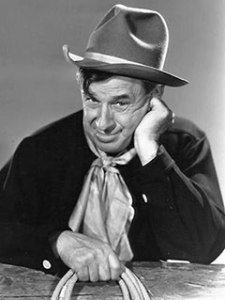 The Ropin’ Fool is a 20-minute silent comedy short starring American cultural icon Will Rogers. I had heard of the man because of his fame as a comedian and a political satirist, but was amazed to see – upon watching this short – that he was also a world-class roper. In fact, as I learned, his extraordinary lariat skills were what brought him to fame on vaudeville in the first place.
The Ropin’ Fool is a 20-minute silent comedy short starring American cultural icon Will Rogers. I had heard of the man because of his fame as a comedian and a political satirist, but was amazed to see – upon watching this short – that he was also a world-class roper. In fact, as I learned, his extraordinary lariat skills were what brought him to fame on vaudeville in the first place.